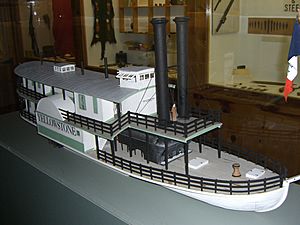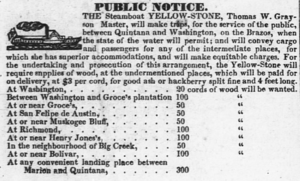Yellowstone (steamboat) facts for kids
Quick facts for kids History |
|
|---|---|
| Name | Yellowstone |
| Owner | American Fur Company (1831) and Thomas Toby & Brother of New Orleans (1835) |
| Operator | Benjamin Young, Anson G. Bennett, Joseph La Barge, Thomas Wigg Grayson, John E. Ross, and James V. West |
| Route | Missouri River, Mississippi River, Brazos River, and the Gulf of Mexico |
| Ordered | November 24, 1830 |
| Builder | Louisville, Kentucky |
| Maiden voyage | April 16, 1831 |
| Fate | unknown, possibly sank in Buffalo Bayou |
| General characteristics | |
| Class and type | Side-wheeler, packet boat |
| Displacement | 144 tons |
| Length | 120 ft (37 m) or 130 ft (40 m) |
| Beam | 20 ft (6.1 m) or 19 ft (5.8 m) |
| Depth | 6 ft (1.8 m) or 5.5 ft (1.7 m) |
| Decks | Three: Hold, Main Deck and Boiler Deck. |
| Installed power | 1 boiler, as built; refitted with two boilers in 1835. |
| Propulsion | Two 18 ft (5.5 m) paddlewheels |
| Capacity | 75 tons, 72 passengers, and 22 crew. |
| Crew | 22 |
| Notes | First steamboat to reach above Council Bluff, Iowa, on the Missouri River (1831); First steamboat to reach mouth of Yellowstone River (1832); Crossed Texan Army on Brazos River in Texas War for Independence (1836). |
The steamboat Yellowstone (sometimes called Yellow Stone) was a special boat with paddle wheels on its sides. It was built in Louisville, Kentucky, for the American Fur Company. This company used it to move furs and supplies on the Missouri River. The Yellowstone was the first steamboat to travel so far up the Missouri River, reaching Council Bluffs, Iowa, and then Fort Tecumseh, South Dakota, in 1831. It also helped the Texas Army during the Texas Revolution in 1836, carrying soldiers across the Brazos River.
Early Journeys on the Missouri River
The Yellowstone was built between 1830 and 1831. It was made for the American Fur Company to help with the fur trade. The boat carried goods between Saint Louis, Missouri, and trading posts along the Missouri River. These posts went all the way up to the mouth of the Yellowstone River in western North Dakota. Before the Yellowstone, fur traders used boats called keelboats. These boats had to be pulled upstream to deliver supplies. Then, they floated downstream with furs.
The Yellowstone started its first trip on April 16, 1831, from Saint Louis. It reached Pierre, South Dakota, on June 19, 1831. This was 600 miles farther than any other steamboat had gone before. This trip made it much easier to travel and trade along the upper parts of the Missouri River. The boat returned to Saint Louis on July 15, 1831, full of furs.
In 1832, the Yellowstone reached the mouth of the river it was named after. A famous artist named George Catlin wrote about this journey.
In 1833, a German scientist, Prince Alexander Philipp Maximilian zu Wied-Neuwied, traveled on the Yellowstone. He was with a Swiss artist named Karl Bodmer. Bodmer drew pictures of the Yellowstone struggling over a sandbar. This drawing might be the most accurate picture of the steamboat we have today.
In July 1833, many people on the Yellowstone got sick with cholera. Many crew members and passengers died. People in nearby towns were scared of the sickness. They even threatened to burn the boat. The captain, Anson G. Bennett, went to St. Louis to find new crew members. He left Joseph LaBarge, who was a clerk and pilot, to protect the boat and the sick crew. The captain soon returned with a new crew.
From 1831 to 1833, the steamboat made regular trips. It used the higher river levels from melting snow in April, June, and July. During winter, ice stopped travel. In late summer, the water was too low for the boat's six-foot depth. So, the Yellowstone worked on the lower Mississippi River. It carried cotton and sugar cane. After its last trip up the Missouri River in July 1833, the steamboat continued working on the Mississippi River. It was under new owners and Captain John P. Phillips.
In November 1835, the Yellowstone went to New Orleans for major repairs. A second boiler was added, and many wooden parts were replaced. It was sold again to new owners. They registered it for trade trips in foreign waters, specifically in what was then Mexican Texas.
Helping in the Texas Revolution
Thomas Toby & Brother bought the steamboat to carry cotton on the Brazos River in Texas. It took cotton bales from farms down to Quintana on the Gulf Coast. The Yellowstone left New Orleans on New Year's Eve, 1835. It carried weapons, ammunition, and 47 volunteers. These volunteers, called the Mobile Greys, were going to help Texans fight for independence from Mexico.
In late March and early April 1836, three Mexican armies were looking for the Texas army. But the Yellowstone kept going upstream to collect cotton. On April 2, Sam Houston, the Texas army leader, sent a message. He told the Yellowstone to stay at Groce's Landing. He wanted it to help his army cross the river. The captain and crew agreed.
On April 12, the Yellowstone began carrying the entire Texas Army across the Brazos River. It took many trips, but they finished by the next afternoon. On April 14, the Texans marched toward San Jacinto. The Yellowstone, still protected by cotton bales, raced downstream. It needed to pass the Mexican camps to reach the Gulf.
The Yellowstone's bell rang loudly, and smoke poured from its stacks. Many Mexican soldiers ran away in fear. They had never seen a steamboat before. One soldier even tried to lasso the smokestack! Others shot at the boat because Santa Anna wanted to capture it. The only damage to the steamboat was bullet holes in its smokestacks. It quickly outran its pursuers.
After the Texans won the Battle of San Jacinto on April 21, 1836, the Yellowstone was nearby. It picked up the wounded Sam Houston. It also carried the new republic's temporary president, David G. Burnet. The captured Santa Anna and 47 Mexican prisoners were also on board. The boat was held for a while to take Santa Anna back to Mexico. However, his return was delayed for many months.
Later that year, the Yellowstone was still working as a packet boat on Buffalo Bayou. It was asked to carry the body of Texas hero Stephen F. Austin for burial. Then, it took mourners back along the Brazos River.
What Happened to the Yellowstone?
No one knows for sure what happened to the Yellowstone. A Texas story says it sank in Buffalo Bayou in 1837. However, there is no official record of this. A record does show that a steamboat with the same name passed through the Louisville and Portland Canal on the Ohio River in the summer of 1837. The Daughters of the Republic of Texas Library in San Antonio is said to have a brass bell. Many believe this bell belonged to the Yellowstone.




